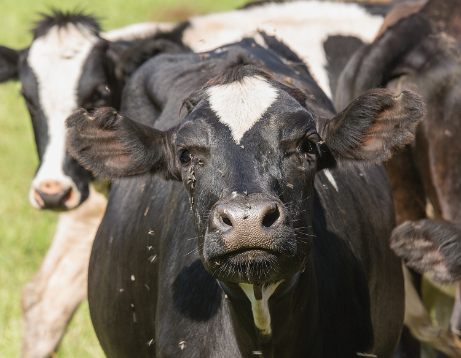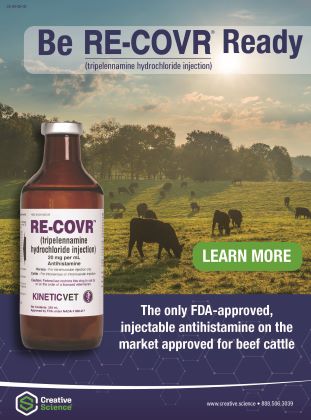Being In Control

By Maura Keller.
Fly control has long been a point of contention for dairy farmers. Whether you manage 50 head of dairy cows in a smaller farm, or 500 head in a larger operation, one thing’s for sure: Fly control is a top concern requiring diligence and understanding of the best products and procedures required to keep animals healthy.
According to M. Wayne Ayers, DVM, senior technical consultant at Elanco Animal Health, the dairy industry has not seen any new products that would fall into a new chemical class for fly control in several years.
However, as the industry continues to learn more about flies in general, and the economic impacts they can have for producers, industry professionals are looking at better ways to use the products currently available.
“We are also looking at the best ways to use fly control products that guard against the potential of resistance and encourage stewardship,” Ayers says.
Ayers points out that the need to understand flies and having choices of several products in different chemical classes is why entities, such as Elanco Animal Health becomes an solid choice as a producer’s fly control partner. For example, Elanco has the largest and most diverse insecticide and parasiticide portfolio among animal pharmaceutical companies, allowing the company to help producers design better and more complete fly control programs across beef, dairy, poultry, and swine species. Because of the company’s broad portfolio made up of multiple insecticide classes, they can help with the rotation of chemical classes to reduce the risk of resistance in fly populations.
Dorane Strouse of Useful Farm Products the biggest trend facing the fly control industry continues to be moving away from using harsh chemical sprays and to using better manure management and incorporating safe products like fly parasites and fly traps.
“The flytraps have become much better and more for specific flies,” says Strouse, who adds that most ranchers have larger pastures or rotate and don’t rely on fly control. Dairies have to use fly control and use a wide variety of products from sprays, granular poisons, ear tags, fly parasites, sticky tapes, and a wide variety of traps. “Our preference is the parasites in combination with sticky tapes and non-toxic traps,” Strouse says.
When farmers are looking for fly control products, several factors must be considered including the species of the fly, the time of year and the region within the U.S where they live.
“There are three major categories of fly control products: on-animal, premise and larvicides,” Ayers says. “The best fly control results from targeting flies with products from all three categories.”
Ayers further explains that within the on-animal category, there are several sub-categories. These include insecticide ear tags, pour-on products, sprays, products for oilers and rubs, dust products, as well as endectocides, which address internal parasites and have knockdown effects on external parasites, including horn flies.
“Within the premise category, there are spray and bait products that attract and kill House flies, fogging agents to kill flying pests, and sprays to target several fly species where they rest in and around animal housing,” Ayers says.
And within the larvicide category, feed-through and spray/spreadable are two subcategories. The feed-through prevents larvae of horn flies and face flies from becoming adults. The spray and spreadable larvicides are used to reduce and prevent house and stable fly larvae from becoming adults.
Key Concerns
So what are the biggest concerns regarding fly control and why should dairy producers incorporate this into their animal production processes?
As Strouse explains, an abundance of flies will irritate producing dairy cows and reduce production and possibly contribute to diseases.
There are four major flies of concern: horn flies, face flies, stable flies and house flies. Each poses its own risk for producers and their cattle, including economic loss, the spread of disease and animal welfare,” Ayers says.
Horn flies pose a large risk because if they are not controlled, it can result in significant weight losses for cow-calf operations. “This can include up to 15 pounds of lost weaning weight per calf and for stocker cattle of up to 50 pounds of gain for the season,” says Ayers, who further explains that an adult horn fly lives on the cow its entire life, only leaving it to lay eggs in fresh feces. The fly feeds up to 30 times a day, taking a small blood meal of about 1 μl (microliter, 1/1000ml) at each feeding. An untreated cow can have 4,000 or more flies on it, which can mean approximately 120,000 bites per day, 5,000 bites every hour, resulting in blood loss of up to 120 mL per day.
“If a cow is being bitten frequently, not only will it not be able to graze as much as it should, leading to reduced milk production for her calf, but the blood loss and discomfort have a significant impact on the cow’s overall well-being,” Ayers says. “Uncontrolled face flies can result in losses due to transmission of Moraxella bovis, the organism that causes pink eye. Pink eye is very painful and can lead to vision loss if left untreated. Calves with a pink eye scar can bring $10-12 less/cwt than a calf without a pink eye scar. Cattle with as few as 12-14 face flies graze about an hour a day less than cattle without face flies.”
Stable flies also bite cows on the legs, causing significant pain and reducing the time spent eating. According to Ayers, this can lead to a decrease in average daily gain of 0.4 pounds The Stable fly bite is the most painful of the four mentioned flies, and the fear of being bitten causes cattle to crowd tightly together to avoid bites, putting the cows in the center of the group at risk of heat stress in the summer.
“House flies are a nuisance for both humans and animals and have been shown to carry more than 100 different pathogens, including bacteria, viruses, fungi and parasites,” Ayers says. “Many of these organisms, such as Salmonella, can pose a serious health risk to both humans and animals. These flies can land on surfaces such as feedstuffs, milk and water buckets, transferring pathogens from place to place.”
Key Considerations
There are certain considerations that cattle ranchers need to make as it relates to fly control that may differ for daily producers. As Strouse explains, no dairy can be without full scale fly control: manure management, fly prevention, fly elimination. Dairies take the calves off the mothers and put them in special calf areas which are notorious fly breeding areas and can lead to many diseases including pink eye.
And Ayers advises dairy farmers that it’s important to approach fly control holistically. This means implementing a program that targets flies in as many ways as possible and where flies rest, feed, and breed. While it is important to choose individual fly control products that fit your operation, it may be equally or more important to manage facilities properly, properly apply the chosen products, and rotate product classes to achieve optimum fly control.
“While it is important to choose individual fly control products that fit your operation, it may be equally or more important to manage facilities properly, properly apply the chosen products, and rotate product classes to achieve optimum fly control,” Ayers says.
It’s also important to understand that an insecticide ear tag serves as a reservoir of sorts for cows to apply the product to their body daily. “Some believe ear tags emit some kind of aura that protects the cow in a bubble, which is not true,” Ayers says. “In reality, the cow spreads the chemical from the ear tag onto her body as she grooms herself. Additionally, she spreads it to her calf’s body as she grooms the calf, and as the calf rubs on her while nursing.”
For a cow-calf pair, an ideal application of insecticide ear tags includes three tags per pair. For the cow, one ear tag should be applied to the front of each ear, with the button on the back of the ear. As Ayers explains, the cow needs a tag in each ear to transfer chemical from the tag to the respective side of her body during normal grooming. For the calf, one ear tag should be applied on either ear.
“The purpose of the tag on the calf is to apply the chemical to the belly of the cow as the calf nurses and not necessarily to protect the calf,” Ayers says.
Some may also believe the tag isn’t working in the days following the application. According to Ayers, it can take up to one week for the chemical in the ear tags to fully cover the cow’s body, so allowing time for the product to work is important.
“Because ear tags have a fixed life of efficacy, timing of application is also key. If applying ear tags too far ahead of fly season, the tags may become depleted before the end of the fly season,: Ayers says. “One may need supplemental fly control when tags near their life expectancy, whether applied too early or in regions with an extended fly season.”
One common mistake producers make is not implementing product rotation. When using ear tags and sprays, it’s important to rotate chemical classes to reduce the risk of resistance. “Often, producers switch product brands but fail to realize the two products belong to the same chemical class,” Ayers says. “It is important to read labels and ask questions if it is not clear to which chemical class a given product may belong.”
In the end, Ayers stresses that effective fly control requires a well-planned program targeting flies where they rest, feed, and breed specific to the species being targeted.
“To increase one’s chances of successful fly control and maintaining animals as comfortable and productive as possible, it is important to plan well ahead of the fly season,” Ayers says.
Strouse advises ranchers to start early, be aggressive and stay safe. “There is a famous saying, ‘One fly killed in May can mean 1,000 less in August.’ In less than a month a fly lives, it can lay 500 eggs and flies increase geometrically if not controlled. Be aggressive with your fly parasites, traps or whatever you use, more is always better,” Strouse says. “Many toxic sprays and chemicals have been eliminated by government regulation and flies have developed resistance to others. They certainly don’t help the health of your animals.”




